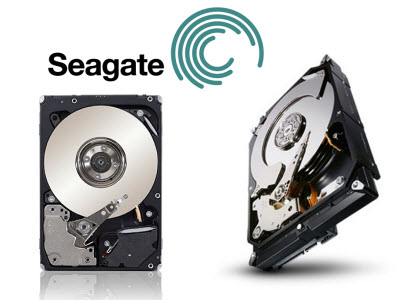Seagate, TDK Demo HAMR Tech for Next-gen Hard Drives
Seagate is demonstrating HAMR tech this week at CEATEC.
This week during CEATEC 2013 in Japan, Seagate Technology and TDK are demonstrating HAMR technology, AKA heat-assisted magnetic recording. This system uses a laser to first heat the platter before magnetically recording data, enabling the drive to write bits of data closer together so that even more data can be stored than when using the standard method.
During the show, Seagate is demonstrating a HAMR-based 2.5 inch 10,000 RPM drive designed for enterprise blade servers in TDK's booth. Seagate's Chief Technology Officer Mark Re told the IDG News Service on Monday that the company is shooting to actually begin delivering HAMR drives in 2016. The tech has only been in active development at the company since around 2005, which is a shorter timeframe than the ten+ year period NAND flash used.
The typical hard drive is expected to hit a wall on data density when the tech reaches 1 terabit per square inch per platter – the standard now is 750 gigabits per square inch. This barrier is due to the substrate's cells that can become unstable and change polarity when they become smaller. Data is stored by changing the magnetic polarity of the cell.
But with the HAMR technology, the HAMR head heats up only the area where the data is to be written, allowing Seagate to use a different kind of disk media with higher coercivity, or the ability for the cells to hold the magnetic charge with which they've been set. Seagate expects to break the 1 terabit ceiling and reach as high a 5 terabits per inch. This would enable 20 TB hard drives by 2020.
Mark Re said that attaching and aligning a semiconductor diode laser to an HDD write head and then implementing near-field optics to deliver heat have been some of the biggest challenges in developing the HAMR technology. Although near-field optics isn't anything new, hard drives would be the largest volume implementation of the tech thus far.
He also added that the cost of HAMR-based drives will likely be the same price as drives sold today. They also won't significantly increase power consumption because the laser merely consumes tens of milliwatts of additional power. The company is demonstrating the 10,000 RPM hard drive to assure skeptics that the technology works, and should become marketable in the next several years.
"They're trying to ward off the skeptics. The technology is very, very difficult, and there has been a lot of skepticism if it will ever make it into commercial products," said IDC's John Rydning, adding that the consensus in the HDD industry seems to be that HAMR won't ship before 2017.
Get Tom's Hardware's best news and in-depth reviews, straight to your inbox.

Kevin Parrish has over a decade of experience as a writer, editor, and product tester. His work focused on computer hardware, networking equipment, smartphones, tablets, gaming consoles, and other internet-connected devices. His work has appeared in Tom's Hardware, Tom's Guide, Maximum PC, Digital Trends, Android Authority, How-To Geek, Lifewire, and others.
-
IndignantSkeptic What the hell?! I heard about his technology ages ago and they are still not going to implement it until ages from now?! It's getting ridiculously depressing how slow the pace of technological advancement is.Reply -
tigger888 @IndignantSkeptikReply
its people like you that dont appreciate what the hell is being done here. instead of saying its impossible to advance, they are taking an absurd idea and actually making it work. upset at how slow it is?! gimme a break.. -
Chaoss It'd be nice to have faster mechanical hard drives, but I believe they are looking in the wrong place for long term solutions. We should have crystal based drives now where your data could last tens of thousands of yearsReply -
lancelot123 If we don't have 20 TB drives well before 2020, I will be disappointed. I just want tech to move faster than that.Reply -
shin0bi272 Im kinda with Skeptik here... I heard about this back in like 2003 and they havent gotten it working yet? I know R&D takes a while but hell we havent seen a working proof of concept yet let alone one come to market. This might be sort of like the drug companies that dont cure diseases anymore they just make stuff so you can live with the disease you have. Hey the hard drives dont need this technology till we cant cram any more bits on the platter using perpendicular recording so we'll wait till then to release it. Why work harder than we have to? Especially since the only things that need these 20tb drives are enterprise storage devices and your extreme home user who wants to put all 1000 of their blurays on one drive.Reply
